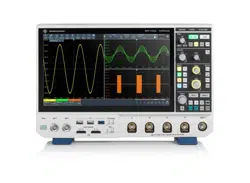Loading ...
Loading ...
Loading ...

Network operation and remote control
R&S
®
MXO 4 Series
390User Manual 1335.5337.02 ─ 05
The Negative-TRansition part also acts as a transition filter. When a bit of the
CONDition part is changed from 1 to 0, the associated NTR bit decides whether
the EVENt bit is set to 1.
– NTR bit =1: the EVENt bit is set.
– NTR bit =0: the EVENt bit is not set.
All negative transitions are disabled by default.
This part can be written into and read as required. Its contents are not affected by
reading.
●
EVENt
The EVENt part indicates whether an event has occurred since the last reading. It
is the "memory" of the condition part. It allows you to detect the occurrence of
events reliably, even if they have changed the state of the CONDition bit for a
very brief interval. It only indicates events passed on by the transition filters.
This part can only be read by the user. Reading the register clears it.
●
ENABle
The ENABle part determines whether the associated EVENt bit contributes to the
summary bit (see below). Each bit of the EVENt part is "ANDed" with the associ-
ated ENABle bit (symbol '&'). The results of all logical operations of this part are
passed on to the summary bit via an "OR" function (symbol '+').
ENABle bit = 0: the associated EVENt bit does not contribute to the summary bit
ENABle bit = 1: if the associated EVENt bit is "1", the summary bit is set to "1" as
well.
This part can be written into and read by the user as required. Its contents are not
affected by reading.
16.5.3 Contents of the status registers
16.5.3.1 Status byte (STB) and service request enable register (SRE)
The STatus Byte (STB) is already defined in IEEE 488.2. It provides a rough over-
view of the instrument status by collecting the pieces of information of the lower regis-
ters. A special feature is that bit 6 acts as the sum bit of the remaining bits of the status
byte.
The STB can thus be compared with the CONDition part of an SCPI register and
assumes the highest level within the SCPI hierarchy.
The STB is read using the command *STB? or a serial poll.
The STatus Byte (STB) is linked to the Service Request Enable (SRE) register.
Each bit of the STB is assigned a bit in the SRE. Bit 6 of the SRE is ignored. If a bit is
set in the SRE and the associated bit in the STB changes from 0 to 1, a service
request (SRQ) is generated. The SRE can be set using the command *SRE and read
using the command *SRE?.
Remote control - status reporting system
Loading ...
Loading ...
Loading ...
